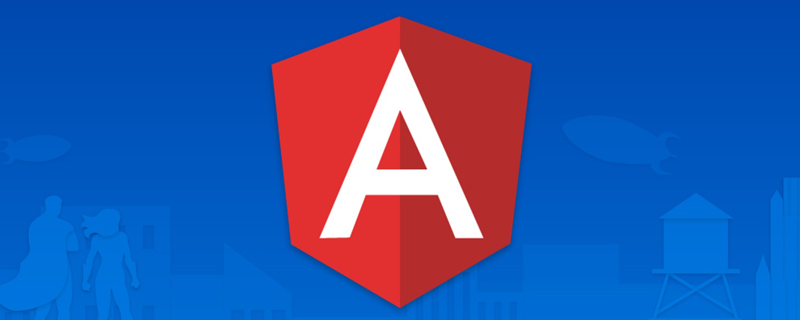Angular组件怎么进行通信?父子组件通信的2种方法
本篇文章带大家了解一下Angular中的组件通信,介绍一下父子组件间通信、无直接关系组件间通信的方法。

在实际的应用中我们的组件将会以树形的结构进行关联,所以组件间的关系主要就是:
【相关教程推荐:《angular教程》】
父子关系
兄弟关系
无直接关系
准备一下我们的环境:
1、创建一个header组件: ng g c components/header
<app-button></app-button> <app-title></app-title> <app-button></app-button>
export class HeaderComponent implements OnInit {
constructor() {}
ngOnInit(): void {}
}2、创建一个title组件: ng g c components/title
<span>{{title}}</span>export class TitleComponent implements OnInit {
public title: string = '标题';
constructor() {}
ngOnInit(): void {}
}3、创建一个button组件: ng g c components/button
<button>{{ btnName }}</button>export class ButtonComponent implements OnInit {
public btnName: string = '按钮';
constructor() {}
ngOnInit(): void {}
}直接调用
适用于父子关系组件,注意点是直接调用使得父子组件的耦合性变高,要明确使用确实需要直接调用。
1、将我们的header组件挂载到app中,使得app和header之间形成父子组件关系
2、使用#为我们的组件起一个名称: <app-header #header></app-header>
3、现在我们的header组件还很空,我们扩展一下,要不然调用什么呢?
export class HeaderComponent implements OnInit {
public name: string = 'HeaderComponent';
printName(): void {
console.log('component name is', this.name);
}
}4、组件扩展好以后我们就可以在父组件app中调用子组件header中的属性和函数了
<app-header #header></app-header>
<p>
调用子组件属性: {{ header.name }}
<button (click)="header.printName()">调用子组件函数</button>
</p>5、第4步是在父组件的html模板中进行操作,有时候我们还需要在父组件的ts类中对子组件进行操作,我们接下来接着演示。
6、我们需要用到一个新的装饰器@ViewChild(Component)
export class AppComponent {
title = 'angular-course';
@ViewChild(HeaderComponent)
private header!: HeaderComponent;
// 声明周期钩子: 组件及子组件视图更新后调用,执行一次
ngAfterViewInit(): void {
// 调用子组件属性
console.log(this.header.name);
// 调用子组件函数
this.header.printName();
}
}@Input和@Output
适用于父子关系组件
1、我们通过在header组件中定义title,来解耦title组件中直接调用导致扩展复杂的问题
2、为title组件中的title属性增加@Input()装饰器: @Input() public title: string = '标题';
3、为header组件新增title属性并赋值: public title: string = '我是新标题';
4、我们再header组件的html模板中这样来使用title组件: <app-title [title]="title"></app-title>
5、一起看看到现在的效果吧,界面虽然丑,但是下次使用组件时title设置是不是方便一点呢?

6、以上步骤实现了父组件的数据传递到了子组件中,那么我们接着来看子组件的数据怎么传递到父组件中呢? 我们一起来用@Output()装饰器实现以下吧
7、在title组件的ts类中增加titleChange属性: @Output() public titleChange = new EventEmitter();
8、在title组件的ts类中定时派发数据
ngOnInit(): void {
// 定时将子组件的数据进行派发
setInterval(() => {
this.titleChange.emit(this.title);
}, 1500);
}9、现在我们来修改header父组件来接收派发来的数据:
<app-title [title]="title" (titleChange)="onChildTitleChange($event)"> </app-title>
onChildTitleChange(value: any) {
console.log('onChildTitleChange: >>', value);
}利用服务单利进行通信
适用于无直接关系组件

1、既然要通过服务来做通信,那我们就先创建一个服务吧: ng g s services/EventBus,并且我们声明了一个类型为Subject的属性来辅助通信
@Injectable({
providedIn: 'root',
})
export class EventBusService {
public eventBus: Subject<any> = new Subject();
constructor() {}
}2、我们为了省事就不重新创建组件了,因为我们的header中的按钮组件和title组件就符合没有直接关系的组件。
3、改造一下我们的button组件,并且添加点击事件来触发triggerEventBus函数
export class ButtonComponent implements OnInit {
public btnName: string = '按钮';
constructor(public eventBusService: EventBusService) {}
ngOnInit(): void {}
public triggerEventBus(): void {
this.eventBusService.eventBus.next('我是按钮组件');
}
}4、在title组件中模拟数据的获取
export class TitleComponent implements OnInit {
constructor(public eventBusService: EventBusService) {}
ngOnInit(): void {
this.eventBusService.eventBus.subscribe((value) => {
console.log(value);
});
}
}利用cookie、session或者localstorage进行通信

1、这个就很简单了,我们还是用title组件和button组件来做演示,这次我们在title组件中将数据保存,在button组件中获取数据。我们仅演示localstorage吧,其他都雷同的。
2、在title组件的ngOnInit()钩子中保存title到localstorage中: window.localStorage.setItem('title', this.title);
3、在button组件中获取数据: const title = window.localStorage.getItem('title');
结语:
本篇我们介绍了Angular的组件通信,为我们拆分后的组件可以进行合理的通信提供了保障,我们到现在组件的使用都是通过引入标签的方式进行。
原文地址:https://juejin.cn/post/6991471300837572638
作者:小鑫同学
更多编程相关知识,请访问:编程入门!!
以上是Angular组件怎么进行通信?父子组件通信的2种方法的详细内容。更多信息请关注PHP中文网其他相关文章!

热AI工具

Undresser.AI Undress
人工智能驱动的应用程序,用于创建逼真的裸体照片

AI Clothes Remover
用于从照片中去除衣服的在线人工智能工具。

Undress AI Tool
免费脱衣服图片

Clothoff.io
AI脱衣机

Video Face Swap
使用我们完全免费的人工智能换脸工具轻松在任何视频中换脸!

热门文章

热工具

记事本++7.3.1
好用且免费的代码编辑器

SublimeText3汉化版
中文版,非常好用

禅工作室 13.0.1
功能强大的PHP集成开发环境

Dreamweaver CS6
视觉化网页开发工具

SublimeText3 Mac版
神级代码编辑软件(SublimeText3)

热门话题
 如何在Ubuntu 24.04上安装Angular
Mar 23, 2024 pm 12:20 PM
如何在Ubuntu 24.04上安装Angular
Mar 23, 2024 pm 12:20 PM
Angular.js是一种可自由访问的JavaScript平台,用于创建动态应用程序。它允许您通过扩展HTML的语法作为模板语言,以快速、清晰地表示应用程序的各个方面。Angular.js提供了一系列工具,可帮助您编写、更新和测试代码。此外,它还提供了许多功能,如路由和表单管理。本指南将讨论在Ubuntu24上安装Angular的方法。首先,您需要安装Node.js。Node.js是一个基于ChromeV8引擎的JavaScript运行环境,可让您在服务器端运行JavaScript代码。要在Ub
 angular学习之详解状态管理器NgRx
May 25, 2022 am 11:01 AM
angular学习之详解状态管理器NgRx
May 25, 2022 am 11:01 AM
本篇文章带大家深入了解一下angular的状态管理器NgRx,介绍一下NgRx的使用方法,希望对大家有所帮助!
 如何使用PHP和Angular进行前端开发
May 11, 2023 pm 04:04 PM
如何使用PHP和Angular进行前端开发
May 11, 2023 pm 04:04 PM
随着互联网的飞速发展,前端开发技术也在不断改进和迭代。PHP和Angular是两种广泛应用于前端开发的技术。PHP是一种服务器端脚本语言,可以处理表单、生成动态页面和管理访问权限等任务。而Angular是一种JavaScript的框架,可以用于开发单页面应用和构建组件化的Web应用程序。本篇文章将介绍如何使用PHP和Angular进行前端开发,以及如何将它们
 浅析angular中怎么使用monaco-editor
Oct 17, 2022 pm 08:04 PM
浅析angular中怎么使用monaco-editor
Oct 17, 2022 pm 08:04 PM
angular中怎么使用monaco-editor?下面本篇文章记录下最近的一次业务中用到的 monaco-editor 在 angular 中的使用,希望对大家有所帮助!
 浅析Angular中的独立组件,看看怎么使用
Jun 23, 2022 pm 03:49 PM
浅析Angular中的独立组件,看看怎么使用
Jun 23, 2022 pm 03:49 PM
本篇文章带大家了解一下Angular中的独立组件,看看怎么在Angular中创建一个独立组件,怎么在独立组件中导入已有的模块,希望对大家有所帮助!
 Angular组件及其显示属性:了解非block默认值
Mar 15, 2024 pm 04:51 PM
Angular组件及其显示属性:了解非block默认值
Mar 15, 2024 pm 04:51 PM
Angular框架中组件的默认显示行为不是块级元素。这种设计选择促进了组件样式的封装,并鼓励开发人员有意识地定义每个组件的显示方式。通过显式设置CSS属性 display,Angular组件的显示可以完全控制,从而实现所需的布局和响应能力。
 项目过大怎么办?如何合理拆分Angular项目?
Jul 26, 2022 pm 07:18 PM
项目过大怎么办?如何合理拆分Angular项目?
Jul 26, 2022 pm 07:18 PM
Angular项目过大,怎么合理拆分它?下面本篇文章给大家介绍一下合理拆分Angular项目的方法,希望对大家有所帮助!







